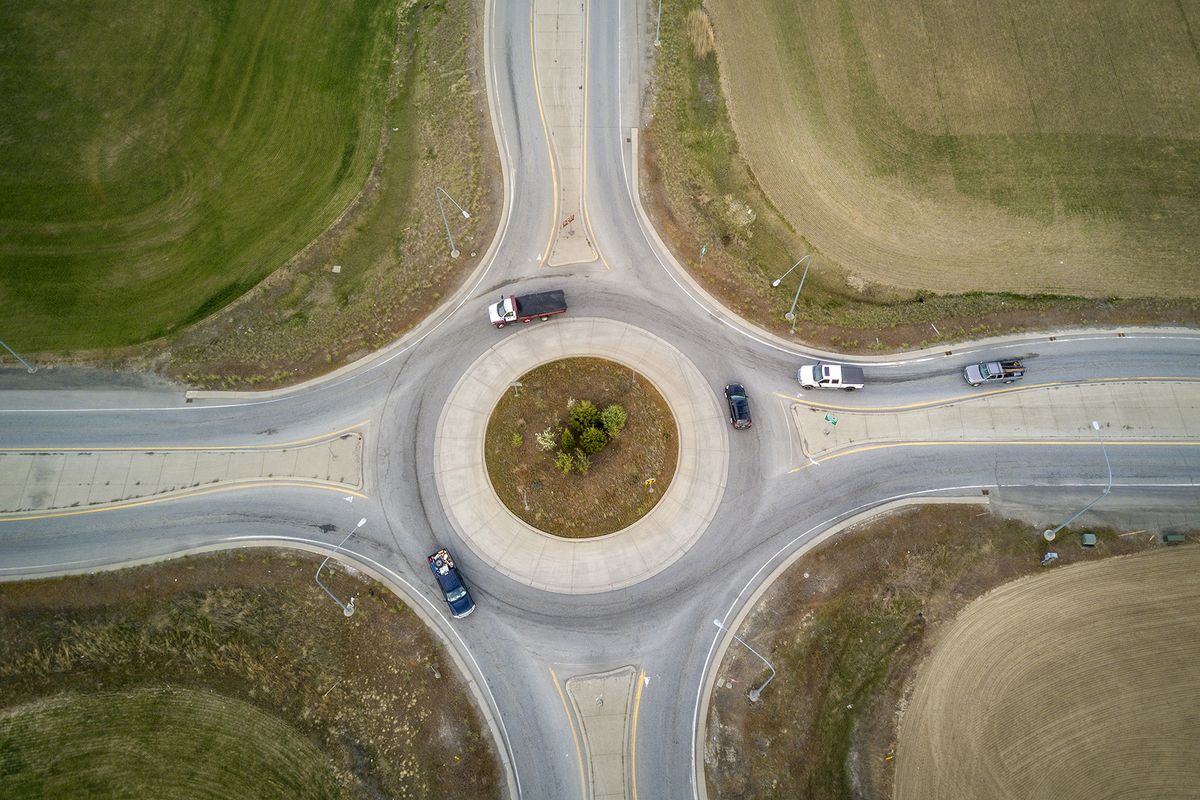Getting There: Despite the complaining, crash data in Deer Park and at Bruce Road show the benefits of roundabouts

You’d be hard-pressed to find a more stereotypical Eastern Washington intersection.
In the spring, it’s surrounded by smooth hills of bright green wheat. Pine-covered mountains, including a snow-dusted Mount Spokane, lie in the distance.
For decades, this idyllic spot at state Highway 206 and Bruce Road near Mead had a reputation for deadliness.
“It would not be uncommon for us to do a fatal crash at that 206 and Bruce intersection,” Washington State Patrol spokesman Jeff Sevigney said.
No one has died there since the installation of a roundabout in 2005, however, and annual collisions have fallen 80%, from 4.9 per year to 1.
Some Washingtonians loathe roundabouts, but the data show they reduce crashes.
The statistics are stark.
From January 1999 to Aug. 31, 2005 – when the Washington State Department of Transportation installed the Highway 206 and Bruce Road roundabout – there were 33 crashes, a fatality, one disabling injury, six minor injuries and 14 possible injuries.
In the 15 years since the roundabout went in, there have been 16 crashes total. There’s been one disabling injury, two minor injuries and three possible injuries.

That decrease in crashes sounds dramatic, but it’s fairly standard to see huge safety improvements after switching from traffic signals – stop signs and lights – to roundabouts.
According to the Federal Highway Administration and Insurance Institute for Highway Safety, installing a roundabout on average leads to a 90% drop in fatalities, a 75% reduction in injuries and a 37% decrease in overall collisions.
Deer Park Mayor Tim Verzal said residents in his city were initially resistant to roundabouts.
The state built two roundabouts on U.S. Highway 395 on the edge of Deer Park in 2018. Verzal said public opposition was strong, even though the intersections had been accident hot spots.
“There was quite a bit of guff on the original project when it first started,” Verzal said. “Probably because they’re so new here in this area and people hate change.”

Now people like them, Verzal said, because they clearly improve safety.
“We haven’t had a fatality; we haven’t had a serious injury since they’ve been put in,” Verzal said.
In the 29 months before roundabouts were installed where Main and Crawford streets intersect with U.S. 395, there were 23 crashes, two disabling injuries, five minor injuries and eight possible injuries at the two intersections.
In the 29 months since their installation, there have been 18 crashes and four possible injuries.
There are multiple ways roundabouts improve safety. They’re simpler for drivers, since they just have to watch the traffic to their left. No one’s speeding through the intersection trying to beat a red light. There aren’t any red lights to run.
But the key is speed.
It’s easier to merge at lower speeds. Ryan Overton, the Washington State Department of Transportation’s spokesman for the eastern region, explained that if a driver is merging with traffic traveling at high speeds, they’re “less likely to make the gap.”
Verzal, who works in construction, said that it used to be difficult for his company’s larger trucks and semis to get onto U.S. 395 because those vehicles can’t go from 0 to 60 mph as quickly as cars and pickups.
“Since these (roundabouts) have been installed, it’s easy,” Verzal said.
Lower speeds also mean when collisions do happen, they’re not as bad. Roundabouts have more fender benders and fewer serious T-bones.
Safety isn’t the only reason to install a roundabout. Multiple studies have shown they reduce delays significantly.
“Here you’re moving,” Verzal said. “You’re at least moving.”

Some of Eastern Washington’s new roundabouts have been installed more to reduce traffic jams than improve safety. For instance, roundabouts at the on and off ramps of Interstate 90 at state Highway 902 were built specifically to accommodate traffic increases associated with the Airway Heights Amazon Fulfillment Center. The state Department of Transportation has installed other roundabouts to accommodate population growth on the West Plains.
Overton said roundabouts are cost-effective and efficient.
“Goodness, we can move a much higher volume of vehicles through a roundabout than a signal,” Overton said.
Roundabouts recently installed in the Medical Lake area have almost eradicated traffic jams that used to leave drivers sitting bumper-to-bumper for five minutes, Overton said.
Eastern Washington’s roundabout boom isn’t stopping anytime soon. There are a handful of roundabouts coming to the area this year.
The state plans to build a roundabout near Loon Lake at U.S. 395 and state Highway 292. It is scheduled for completion in 2022. Three roundabouts will be built on Geiger Boulevard off of I-90.
Overton said people don’t resist roundabouts like they used to.
“Now people are asking for them,” he said. “People should expect more of them in the future.”